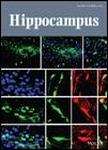版权所有:内蒙古大学图书馆 技术提供:维普资讯• 智图
内蒙古自治区呼和浩特市赛罕区大学西街235号 邮编: 010021

作者机构:Univ Amsterdam SILS Ctr Neurosci Cognit & Syst Neurosci Grp Postbus 94246 NL-1090 GE Amsterdam Netherlands Univ Amsterdam Res Prior Area Brain & Cognit Amsterdam Netherlands Radboud Univ Nijmegen Donders Inst Brain Cognit & Behav Nijmegen Netherlands Radboud Univ Nijmegen Med Ctr Nijmegen Netherlands Otto von Guericke Univ Inst Cognit Neurol & Dementia Res Magdeburg Germany German Ctr Neurodegenerat Dis Magdeburg Germany UCL Inst Cognit Neurosci London England
出 版 物:《HIPPOCAMPUS》 (海马)
年 卷 期:2021年第31卷第7期
页 面:737-755页
核心收录:
学科分类:1002[医学-临床医学] 1001[医学-基础医学(可授医学、理学学位)] 10[医学]
基 金:Alzheimer Nederland Amsterdam Brain and Mind Project H2020 European Research Council Horizon 2020 Framework Programme European Research Council (ERC) Funding Source: European Research Council (ERC)
主 题:contextual processing hippocampus multisensory integration perirhinal cortex spatial coding
摘 要:The perirhinal cortex is situated on the border between sensory association cortex and the hippocampal formation. It serves an important function as a transition area between the sensory neocortex and the medial temporal lobe. While the perirhinal cortex has traditionally been associated with object coding and the what pathway of the temporal lobe, current evidence suggests a broader function of the perirhinal cortex in solving feature ambiguity and processing complex stimuli. Besides fulfilling functions in object coding, recent neurophysiological findings in freely moving rodents indicate that the perirhinal cortex also contributes to spatial and contextual processing beyond individual sensory modalities. Here, we address how these two opposing views on perirhinal cortex-the object-centered and spatial-contextual processing hypotheses-may be reconciled. The perirhinal cortex is consistently recruited when different features can be merged perceptually or conceptually into a single entity. Features that are unitized in these entities include object information from multiple sensory domains, reward associations, semantic features and spatial/contextual associations. We propose that the same perirhinal network circuits can be flexibly deployed for multiple cognitive functions, such that the perirhinal cortex performs similar unitization operations on different types of information, depending on behavioral demands and ranging from the object-related domain to spatial, contextual and semantic information.